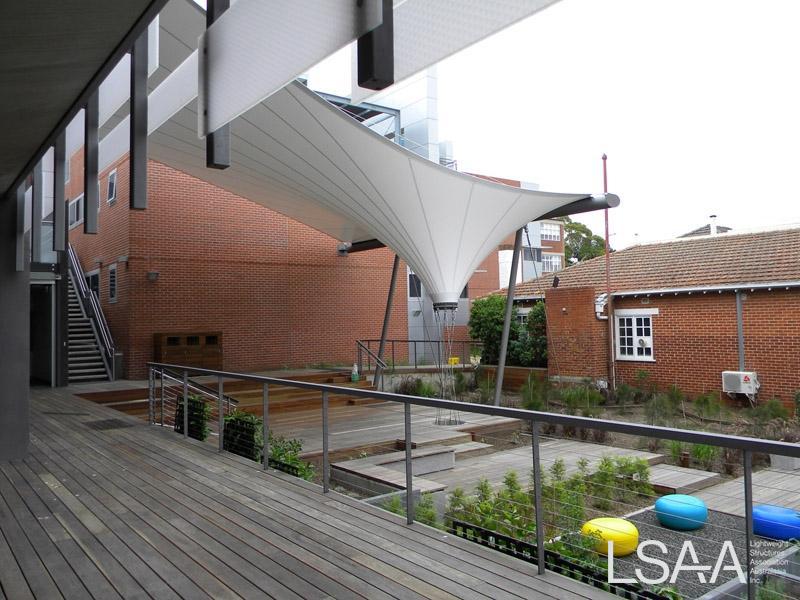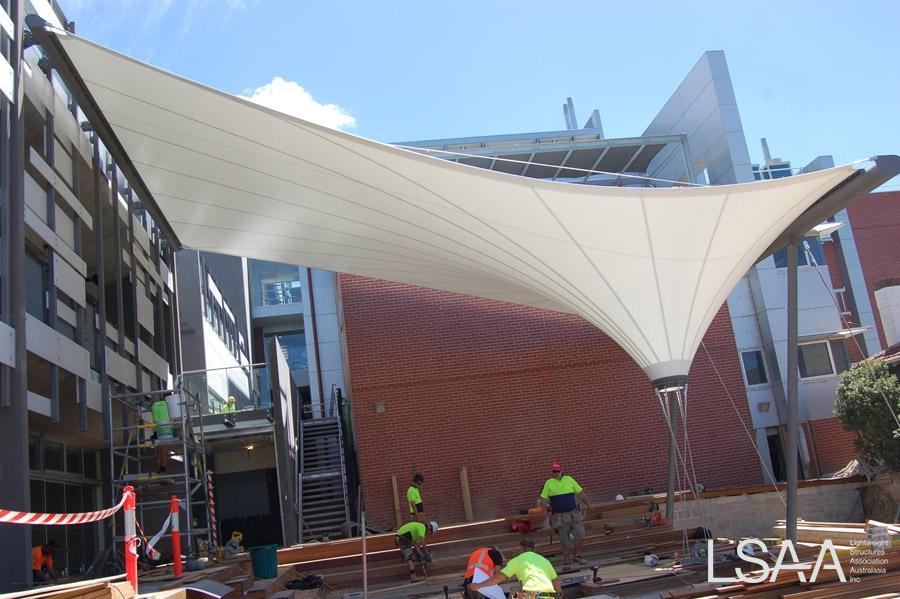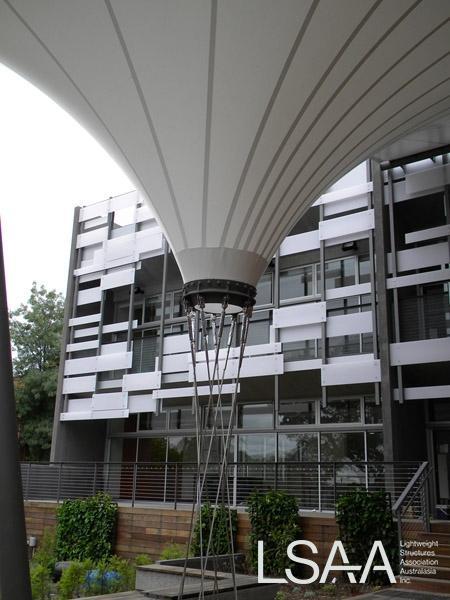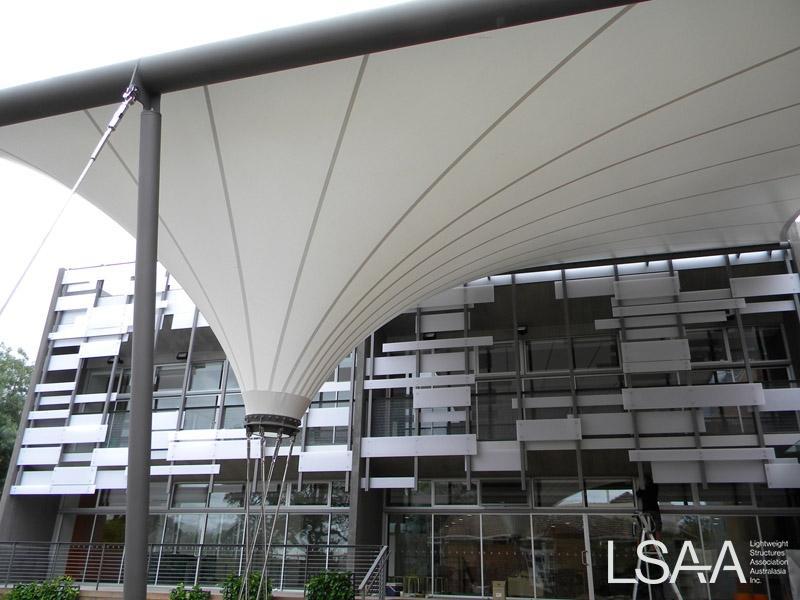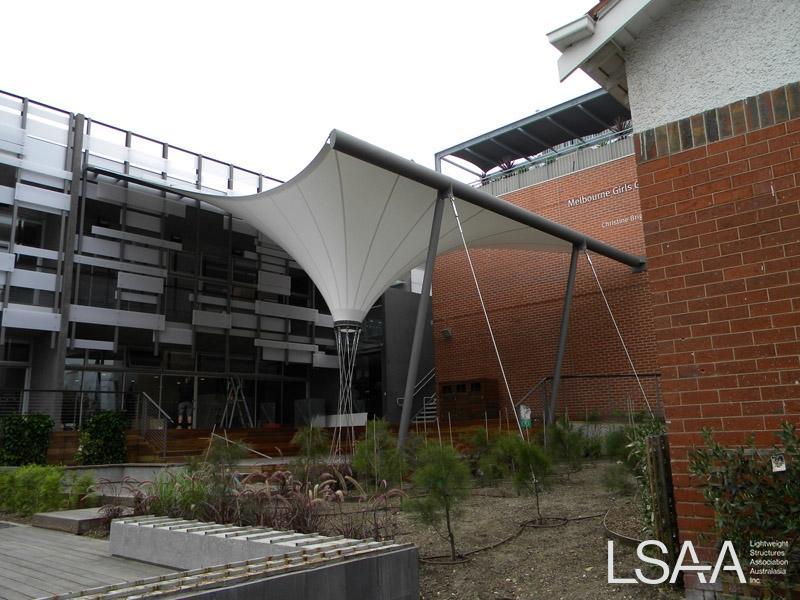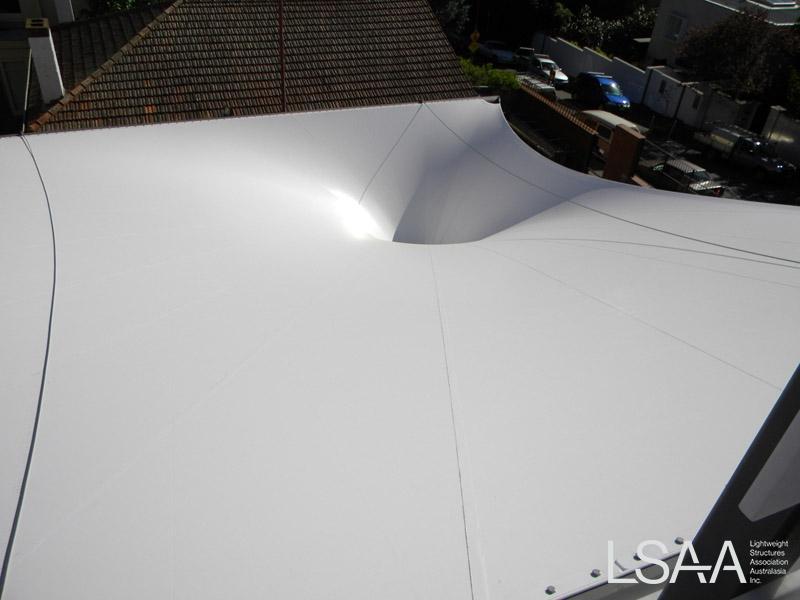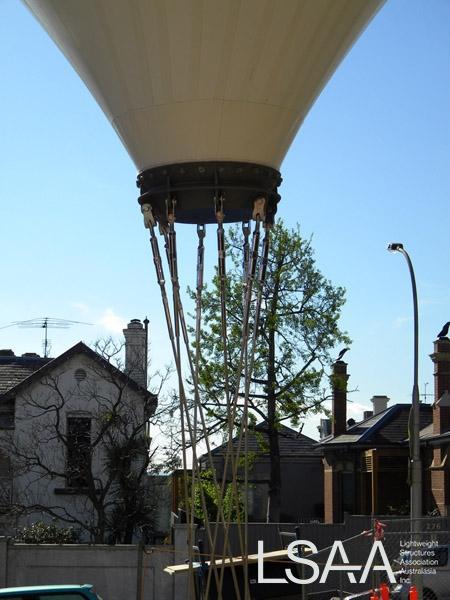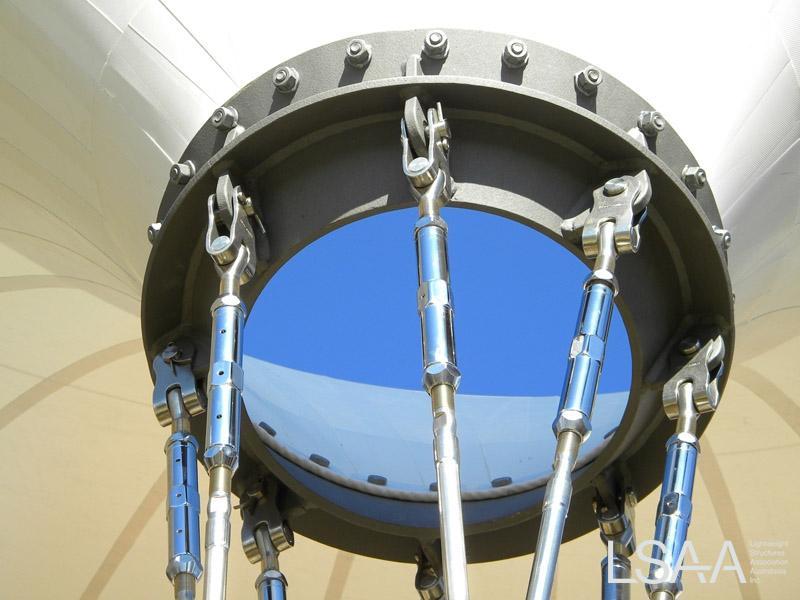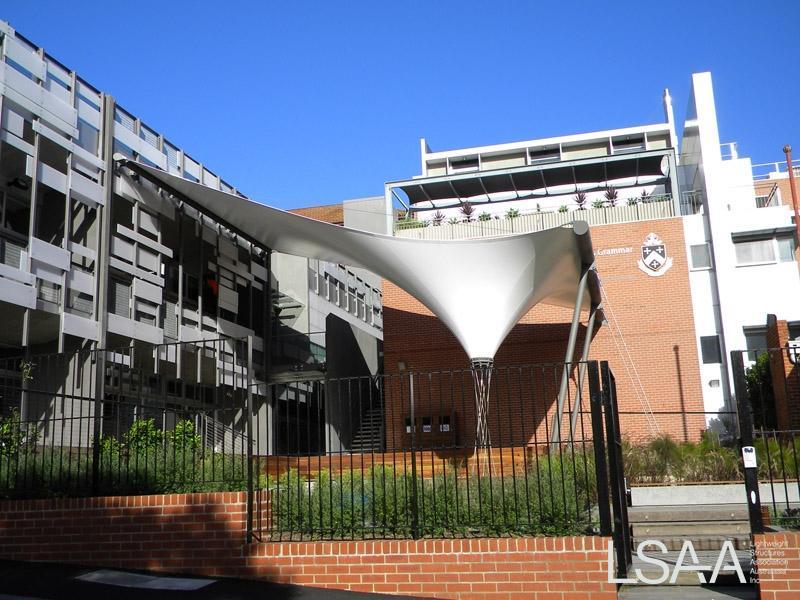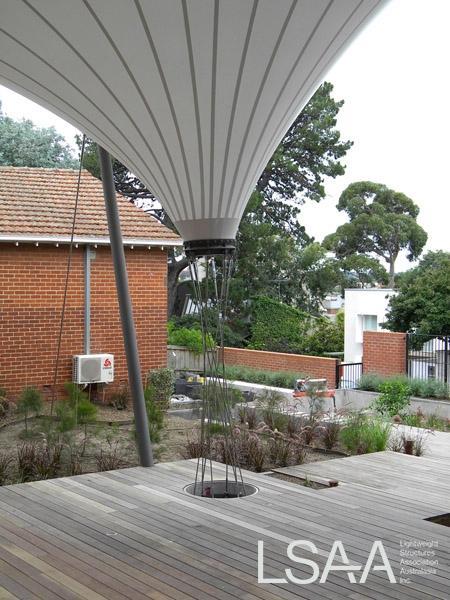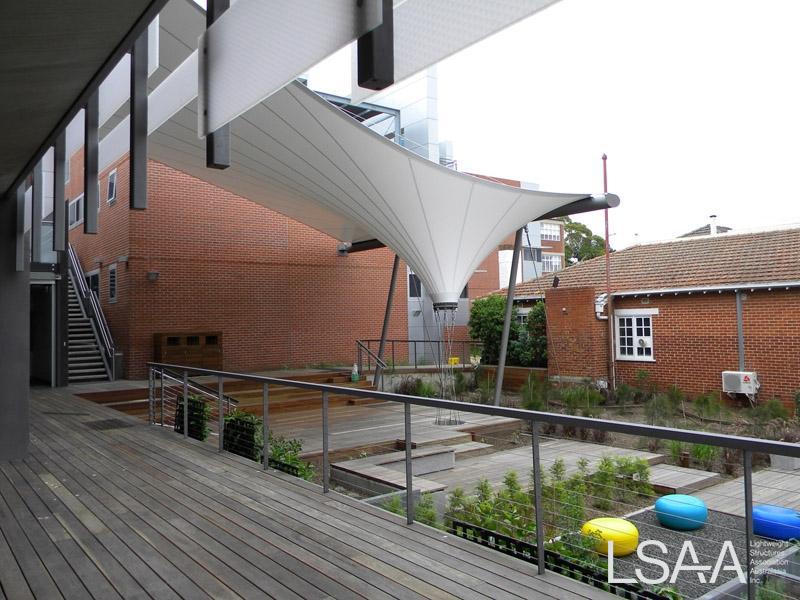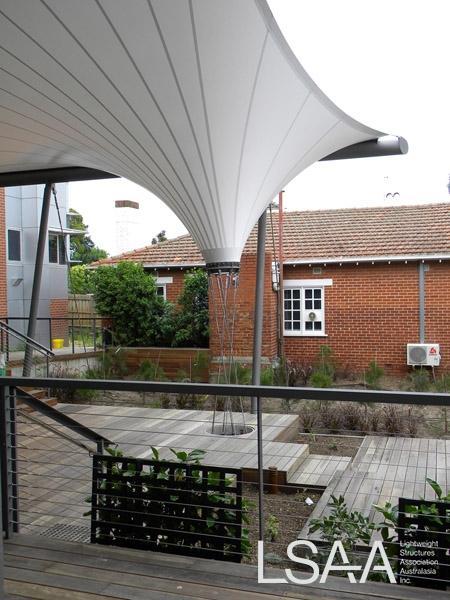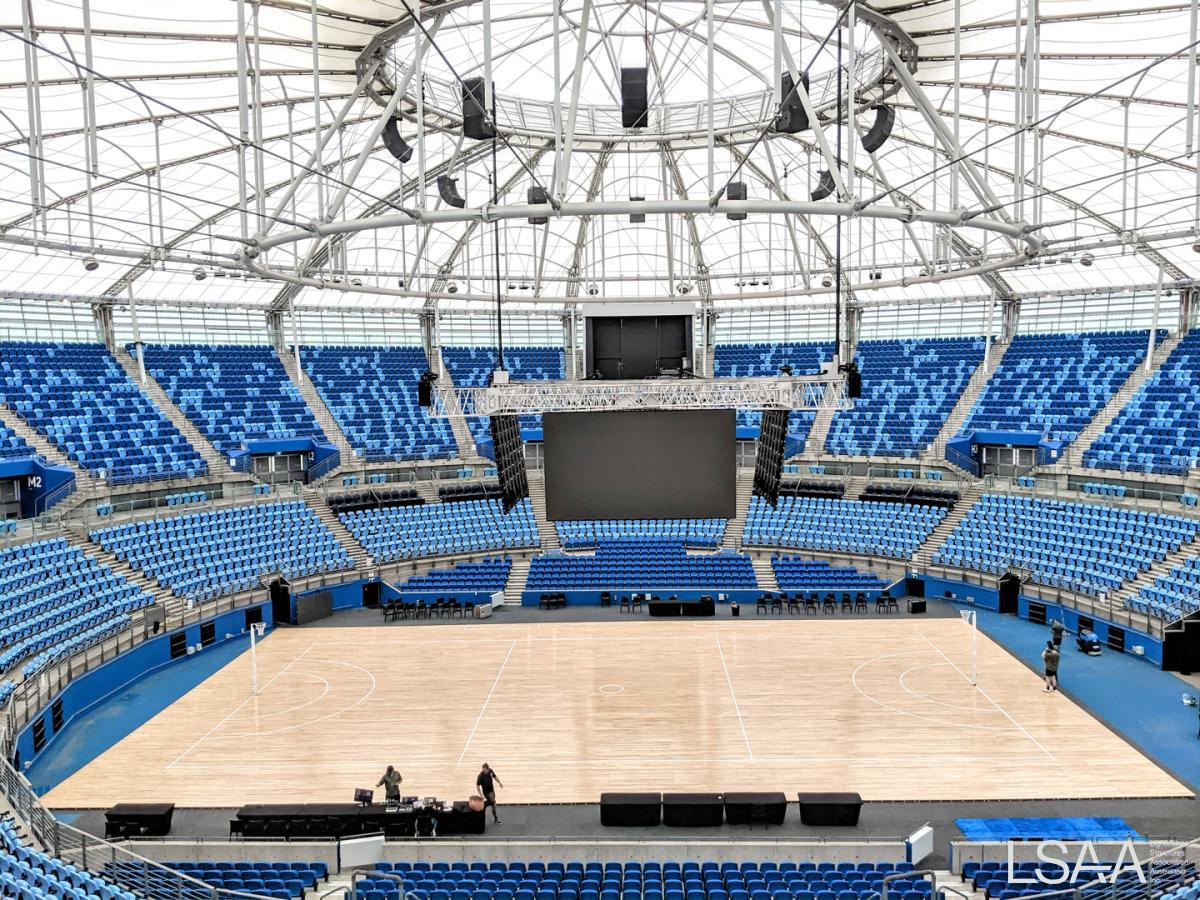This project was entered in the LSAA 2011 Design Awards (Cat 1, 1968)
PROJECT DESCRIPTION
Inverted conic covering a communal deck for year 5 & 6 girls at Melbourne Girls Grammar
The structural form is an asymmetric inverted conic, with what is basically a rectangular upper perimeter. In plan the area covered is small, about 12.5m by 11m, and the height varies from 3m at the bale ring to 5.5m at the lower edge to 9m at the highest edge
The conical form is asymmetrical about all axes. The bale ring has been set close to one corner so that the inverted conical shape is accentuated by being well away from the adjoining buildings to which it is attached, and so that the stormwater drainage through the bale ring has minimal interference with use of the deck on wet days.
The function of the structure is to provide critical protection of the school students from the elements during breaks in their school day, creating an outdoor leisure environment that mixes native plants with modern aesthetic material technology. It provides a space where the children can relax and briefly escape the physical confines of school. Even whilst raining, the children can retreat to this area and have their senses stimulated by the rain drumming on the tensioned fabric whilst the water is collected and pushed along the highly strung cables, creating a cylinder of rushing water. Classes can be held on the tiered decking during most weather conditions.
The inverted conic shape is attached to buildings on the south and west sides, and rises high to open edges on the east and north sides. The shape has been designed to allow morning light to penetrate all year around, whilst the northern sun penetration is tailored to the seasons. In winter, the low sun penetrates and warms all areas of the deck, even though it it is still protected from rain and prevailing southerly and westerly winds. In summer the deck is protected from the high sun by the outer edges, and kept protected from hot afternoon sun by the adjoining buildings.
This structure and its environment was designed and constructed during one of the most devastating droughts Victoria was endured, where water and its conservation is paramount. In this project, the water is gathered in this giant funnel and collected in the enormous water tanks deep beneath the landscaped gardens. This water is then used to irrigate the plants, ensuring their survival even when water restrictions prevent use of mains water.
DESIGN / FABRICATION / INSTALLATION BRIEF
The architects had conceived the deck as a communal space and wanted to provide shelter to it without it feeling enclosed. A new building of significant height was being constructed on the south side, and an existing 4-storey building was located on the western side.
The entrant worked with the architects right from the conceptual stage, and soon developed the inverted conic form. Other constraints and requirements were then considered in developing the detail, including
- weather protected path of travel from the south ,
- a sense of separation from the older building to the west
- minimization of supports through the deck and in the gardens, and location of these supports away from play spaces and paths of travel
- protection from rain
- sunlight penetration summer and winter
- inspiring shape and form appropriate to a venue for inquiring minds keen to learn and discover
STRUCTURAL SYSTEMS
The structural expression minimizes the appearance of supports by attaching the high southern edge into the facade of the new building, with the fixing beam incorporated into a pattern of screens which stand off the facade to provide shading and visual screening.
The north edge is attached to a circular hollow section on two struts which lean away from the structure and have a single cable guy for each strut, providing a clear visual statement as to the development of tension in the fabric surface. Lateral restraint is provided by a single attachment of one end of the CHS to the existing building. The struts and guys are set partway along the CHS to emphasis the floating cantilever at the outer end and to balance out structural actions on this member. Although the strut bases are designed as fixed, overhead safety cables are provided in inconspicuous locations to ensure stability of steel elements in the event of loss of fabric tension.
Catenary edge cables are provided on the east and west sides to ensure visual lightness of the structure is maintained.
Post bases and tie-downs are connected to bored piers drilled into the mudstone, so the expression of foundations is minimal. The bale ring tiedown uses eight stainless steel cables to form a hyperbolic paraboloid shape which also directs rainwater runoff into a collection pit.
The membrane geometry was quite difficult to achieve because of the high degree of offset of the conic. At first pass the contractor advised they could not pattern the required shape without using over-fabric cables. These introduced folds into the fabric shape which the architect did not want, so the entrant worked closely with the specialist analysis engineers to demonstrate the stress fields and patterning which allowed the design shape to be developed with fabric only, providing the smoothly contoured conic shape which was eventually constructed.
A fabric pre-tension of nominally 1.5 kN/m in warp and weft directions was used as the basis for the fabric tension, with higher stresses obviously being developed in the narrow conic area.
Other design loads included roof live load of 0.25 kPa and wind loads to AS 1170.2
MATERIALS
Cost and durability were both important, so a PVDF/PVC coated polyester fabric was used, with galvanized cables for the guys and edge cables, and stainless steel for the elements closer to the users such as the bail ring tie-down cables. The main steel elements were coated with a high performance paint system (blast clean, inorganic zinc primer, and epoxy top coats) to provide in excess of 30 years durability in this environment.
The fabric used was Ferrari 1002 Fluotop T, from France, and all elements including fabric, structural steel and cables were fabricated in Australia.
FABRICATION
A detailed site survey was carried out to confirm geometry of all connection points including set out and as-constructed positions for footings.
Shop details for steelwork were prepared and reviewed by the design engineer, and fabric patterns were prepared and reviewed by the design engineers. The details were developed to provide as much tolerance as possible, with adjustment available in all fabric connections.
Membrane fabrication used overlap seams and high frequency welding. Fabric tolerances were to within 5mm.
Steel fabrication was by conventional methods, and steelwork fabrication tolerances were 2mm.
COLLABORATION, CONSTRUCTION AND MAINTENANCE
The design was a collaborative effort between the designer/engineer and the architect for the early stages when the concept was developed, then required more detailed collaboration between the designer/engineer, the specialist engineer, and the contractor to ensure the vision of the original concept was delivered without compromise.
Construction was reasonably simple, with main steel supports at each end being installed, fabric being attached to those, then final tensioning being done by catenary cables and the conic tie-down cables.
Little maintenance will be required as steel and cable components are designed for long life with no attention other than periodic inspection.
The fabric will need to be cleaned, and access for this is easily obtained by boom lift or cherry picker. Frequency of cleaning will depend on how much soiling occurs, but the area is not heavily industrialized and annual cleaning is expected to suffice.
CREDITS
Project Number: 1968
Title: Melbourne Girls Grammar School Cover to Communal Deck
Location: 86 Anderson St, South Yarra, Vic 3141
Entrant: SEMF Pty Ltd
Role: Designer & Engineer
Client: Melbourne Girls Grammar School
Architect: Sally Draper & Associates
Structural Engineer: SEMF
Spec Consultant: Wade Design Engineers
Others:
Builder: Oasis tension Structures
Fabricator: Oasis Tension Structures
Steelwork etc:


